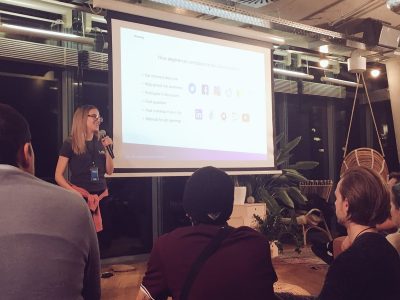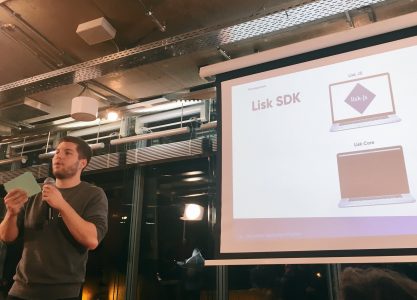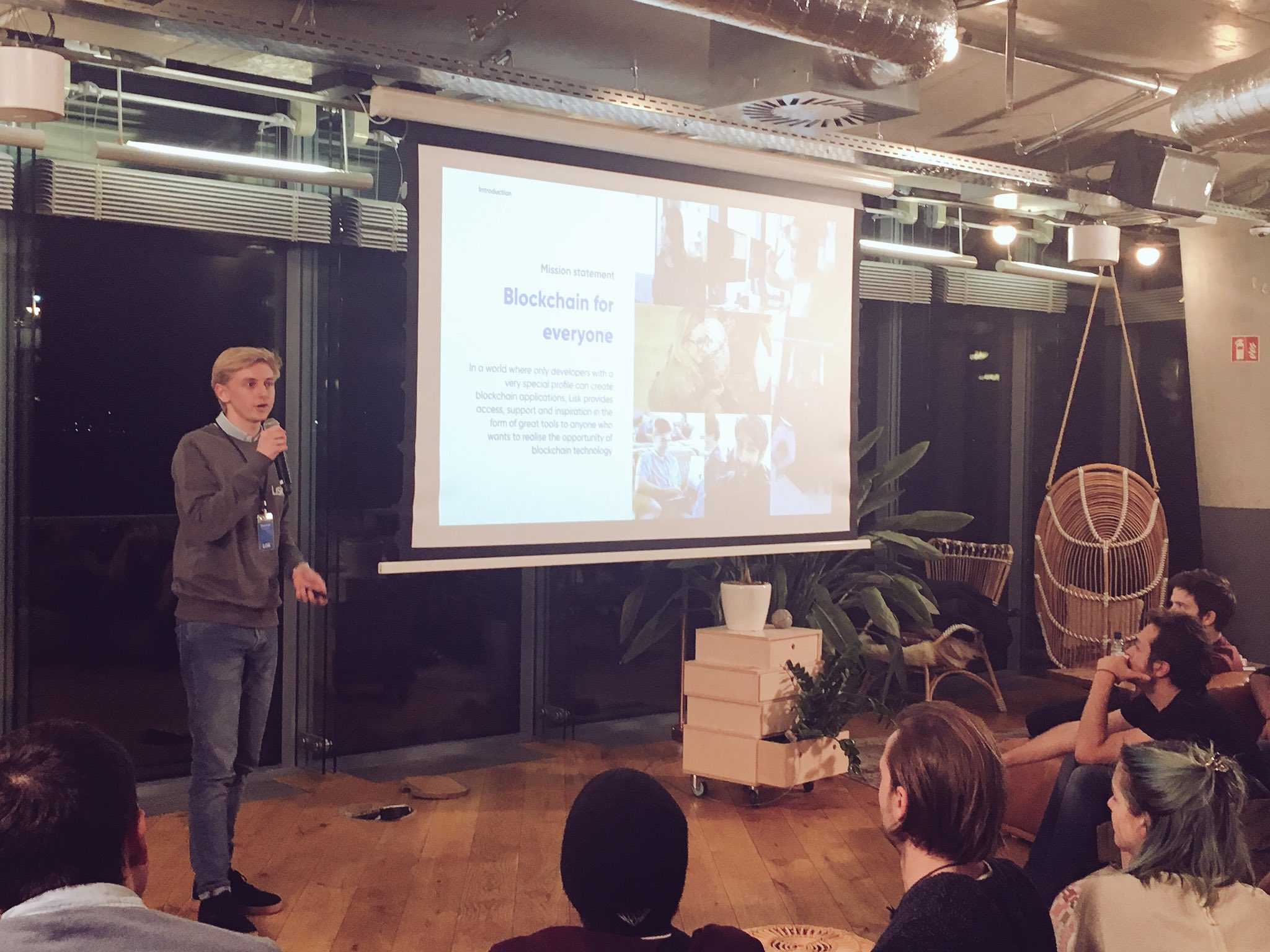Following our overview of Lisk’s Berlin Meetup, we present a technical breakdown of what the Lisk team members presented to their audience.
Opening
Marketing lead Thomas Schouten kicked off the meeting. He announced that a new community manager will be joining the company the following week. Schouten reminded the audience of the Lisk mission statement, namely making blockchain accessible for everyone. A big clue to the direction the night would swing.
As seen on his presentation slide:
In a world where only developers with a very special profile can create blockchain applications, Lisk provides access, support and inspiration in the form of great tools to anyone who wants to realise the opportunity of blockchain technology.
Marketing

Lindsay Buescher, marketing manager, praised Reddit for being Lisk’s top community. She revealed that the team have high ambitions for Lisk meetups in 2018.
Now that the once-limiting Ambassador Program that had 1 ambassador per country has been exchanged for a “fair and decentralized” model, more people passionate about Lisk can become involved. Buescher added that they are working on a roadmap and will be issuing merchandise kits in 2018 that would ease the marketing and meetup logistics for the community. An upcoming events page was also mentioned. Finally, she added that for Lisk Chat, they will be adding moderators, guidelines, and new chat rooms.
She reminded the general public and developers alike on how to get involved with Lisk. For the community, this can take the form of engaging with the company’s social media channels, spreading awareness about Lisk, participating in discussion, fielding questions, hosting meetups, and job opening referrals. Developers were once again invited to get involved by running nodes, helping them moderate online platforms, building tools that benefit the ecosystem, contributing to GitHub projects, and reporting bugs.
The audience was informed that the bounty program would be revamped, itself worth US$40 million, and would also be used to support future Lisk projects.
Schouten expanded on Buescher’s marketing and communications introduction. He added that the Lisk team will be adding developer workshops to their community repertoire, and that the current 6-person marketing team will soon be joined by a new designer.
Lisk City: The Ecosystem
Schouten then introduced the concept of the “Lisk City”.
In an attempt to illustrate Lisk’s role as a platform, he likened the company’s ecosystem to a “city of blockchain technology”. With a Sims-esque cityscape visual up on the screen, he compared the Lisk main chain to the main roads, side chains to side roads, and houses to blockchain applications.
Schouten expanded on this analogy by naming Lisk Core the blueprint, Lisk JS the toolkit, Lisky the construction team, JavaScript developers building contractors and, the biggest surprise of the evening, Lisk desktop and web apps as management. This would again be referred to and expanded on by Max Kordek later in the meeting.
In terms of tokens, Schouten explained that they will make them intra-operable across the Lisk network, with sidechain tokens the “driveway” and mainchain tokens’ “toll” fees. He added:
“The faster we grow, the faster we all grow.”
In terms of blockchain developments, he called on developers to work on modules and scripts (Dapps) to build out this city, adding that the ecosystem would evolve through tools provided by HQ and by independent developers, making it a win-win for everyone.
Lisk JS
Lisk JS full-stack lead Tobias Schwarz gave the audience an overview of the goals, benchmarks, and development stack for Lisk JS, as well as its key components.
He revealed that the JS roadmap will be published next month, alluding to encryption capabilities that were not available in previous versions of Lisk. The current JS version v0.5.0 will be replaced with v1.0.0, with versions 1.1.0 and 2.0.0 on the horizon for next year. Updates include:
v1.0.0.
- Modularised crypto, transactions, and API
- Clearer names and es6 and es7 code (according to the team, no uses have yet been found for es9)
- Encryption and signing
- More developer-oriented
v1.1.0.
- Separation of modules into individual packages
- Improved security thanks to database-wide strict types
v2.0.0
- Sidechain creation
- Sidechain transactions creation
Lisky
Will Clark, full-stack lead for Lisky, introduced this ingenious new element. This deceptively simple command line interface (CLI) wrapper that wraps around Lisk JS takes the form of a command line tool.
It allows for simplified input and output to enable automation and ease scripting. This will enable Dapps sidechains through a non-interact node, taking shape in an action creator. Basically, developers don’t need to get their hands all that code-dirty; Lisky will do much of the legwork (aka schlep work) for you.
The roadmap includes current version v0.2.0. with the following features:
- Configuration views and updates
- Passphrase encryption and decryption
- Message encryption and decryption
- Blockchain info on accounts, blocks, delegates, and transactions
Commands in upcoming v0.3.0, on the other hand, will add:
- Account creation
- Transaction creation that includes transfers, second passphrase registrations, delegate registrations, vote casting, and multi-signature account creation
- File inputs thanks to Lisky scripting
And finally, v1.0.0, which will be released early next year, will feature:
- Signing and verification messages
- Signing and verification transactions
- Broadcast transactions
Max Kordek

Kordek was the presenter everyone was waiting on. He started out by reiterating that the theme of the night was development.
He kicked off by reiterating the company’s strategic direction, a promise they’d made in 2016:
- Security
- Usability
- Accessability
To that end, he spoke about the importance of concentrating on features users actually need, having the best UX, and taking their time to focus on making Lisk a success instead of rushing, the way other companies in this space sometimes do.
Speaking about the development roadmap for Lisk Core, he gave the following details for Q4 2017’s Core 1.0:
- Rewriting the peers module to allow P2P communication via WebSocket protocol
- Redesign of account ledger to improve block processing efficiency
- Redesign of API endpoints
- Adding unit test coverage for peers, blocks, transactions, verification, and API-related logic
He stressed that security is of the utmost importance, and that they are working hard to remove security holes.
He rounded off with the importance of the planned desktop and web apps as a key strategy to aid developer usability, a proposed decentralized exchange, and the merger of Lisk Nano and Explorer (read our summary of Kordek’s announcements at the presentation).
According to the co-founder, greater scalability of the Lisk ecosystem is crucially important and serves as their benchmark. He said that through their new dynamic transaction fee system, problematic network load would be addressed.
Kordek added that development is unpredictable, but they are bargaining on completing Core 1.0 by the end of 2017, a new fee and address system along with modularization by March 2018, custom tokens and Dapp registrations by June 2018, and the decentralized exchange and sidechain withdrawal deposits by October 2018.
Watch the full presentation:

